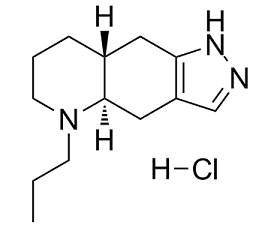(-)-Quinpirole HCl
This product is for research use only, not for human use. We do not sell to patients.

For small sizes, please check our retail website as below: www.invivochem.com
| Size | Price | Stock |
|---|---|---|
| 50mg | $700 | Check With Us |
| 100mg | $1100 | Check With Us |
| 200mg | $1650 | Check With Us |
Cat #: V19599 CAS #: 85798-08-9 Purity ≥ 98%
Description: (-)-Quinpirole HCl [(-)-LY 171555] is a highly potent psychoactive drug and research chemical which acts as a high affinity and selective D₂ and D₃ receptor agonist
Top Publications Citing Invivochem Products
Publications Citing InvivoChem Products
Product Promise

- Physicochemical and Storage Information
- Protocol
- Related Biological Data
- Stock Solution Preparation
- Quality Control Documentation
| Molecular Weight (MW) | 255.79 |
|---|---|
| Molecular Formula | C13H22ClN3 |
| CAS No. | 85798-08-9 |
| Protocol | In Vivo | DA content is left brain biased across groups, and although this asymmetry appears greater in saline controls than all drug-treated groups, there is not a significant interaction between Side and Group. When each side is considered separately it can be seen that in the left brain structure, DA levels progressively decrease with chronic quinpirole treatment, with the QQ rats differing significantly from saline controls. In contrast, right cortical DA levels are only altered significantly (increased) by acute Quinpirole. It can be found that DOPAC levels are also left brain biased across groups. However, no significant Group or interaction effects are found. Rats receiving acute Quinpirole show a selective increase in DA content and decrease in turnover ratio, relative to either saline controls or the QS group. Sensitized (QQ) rats however, have elevated DOPAC levels in comparison to the acute quinpirole group. In striatum as well, all three measures of DA function differed significantly across groups (DA, F3,33=6.27, P=0.0020; DOPAC, F3,33=7.98, P=0.0004; turnover ratio, F3,33=16.85, P<0.0001). In the acute quinpirole rats, both DOPAC and turnover ratio are significantly reduced relative to all other groups. In QQ rats, DOPAC levels are significantly greater than all other groups, while for turnover ratio, both chronic quinpirole groups were increased compared to both chronic saline groups |
|---|
These protocols are for reference only. InvivoChem does not
independently validate these methods.
| Solvent volume to be added | Mass (the weight of a compound) | |||
|---|---|---|---|---|
| Mother liquor concentration | 1mg | 5mg | 10mg | 20mg |
| 1mM | 3.9095 mL | 19.5473 mL | 39.0946 mL | 78.1891 mL |
| 5mM | 0.7819 mL | 3.9095 mL | 7.8189 mL | 15.6378 mL |
| 10mM | 0.3909 mL | 1.9547 mL | 3.9095 mL | 7.8189 mL |
| 20mM | 0.1955 mL | 0.9774 mL | 1.9547 mL | 3.9095 mL |
The molarity calculator equation
Mass(g) = Concentration(mol/L) × Volume(L) × Molecular Weight(g/mol)
Mass
=
Concentration
×
Volume
×
Molecular Weight*
The dilution calculator equation
Concentration(start)
×
Volume(start)
=
Concentration(final)
×
Volume(final)
This equation is commonly abbreviated as: C1 V1 = C2 V2
Concentration(start)
C1
×
Volume(start)
V1
=
Concentration(final)
C2
×
Volume(final)
V2
Step One: Enter information below
Dosage mg/kg
Average weight of animals g
Dosing volume per animal µL
Number of animals
Step Two: Enter the in vivo formulation
%DMSO
+
%
+
%Tween 80
+
%ddH2O
Calculation Results:
Working concentration:
mg/ml;
Method for preparing DMSO master liquid:
mg
drug pre-dissolved in
µL
DMSO(Master liquid concentration
mg/mL)
,Please contact us first if the concentration exceeds the DMSO solubility of the batch of drug.
Method for preparing in vivo formulation:
Take
µL
DMSO master liquid, next add
µL
PEG300, mix and clarify, next add
µL
Tween 80,mix and clarify, next add
µL
ddH2O,mix and clarify.
Note:
- (1) Please be sure that the solution is clear before the addition of next solvent. Dissolution methods like vortex, ultrasound or warming and heat may be used to aid dissolving.
- (2) Be sure to add the solvent(s) in order.




































